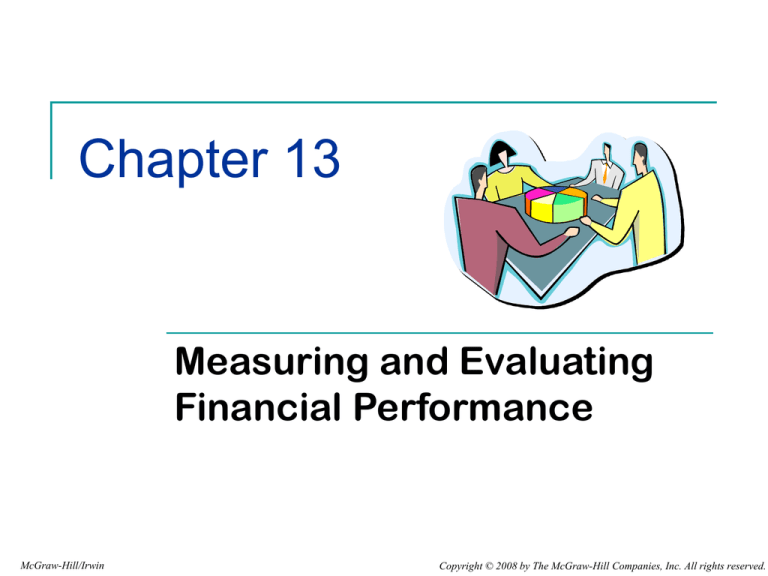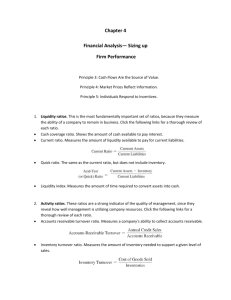
Chapter 13
Measuring and Evaluating
Financial Performance
McGraw-Hill/Irwin
Copyright © 2008 by The McGraw-Hill Companies, Inc. All rights reserved.
Learning Objective 1
Describe the purposes
and uses of trend and
ratio analyses.
13-2
Trend and Ratio Analyses
Trend analyses are
conducted to help
financial statement users
recognize important
financial changes that
unfold over time.
Ratio analyses, on the
other hand, are conducted
to understand
relationships among
various items reported in
the financial statements.
13-3
Learning Objectives 2 & 3
LO 2
Calculate financial trends
and ratios.
LO3
Interpret the results of
trend and ratio analyses.
13-4
Calculating Trends
Horizontal
Analyses
Time-Series
Analyses
13-5
Calculating Trends
Calculating Change in Dollar Amounts
Dollar
Change
=
Current Year
Figure
–
Base Year
Figure
13-6
Calculating Trends
Calculating Change as a Percentage
Percentage
Change
=
Dollar Change
Base Year Figure
×
100%
13-7
Horizontal Analysis
The following slides illustrate a trend
analysis for Matrix, Inc. for the years ended
December 31, 2006 and 2005. We will begin
with the asset section of the company’s
comparative balance sheets.
13-8
Horizontal Analysis
Matrix, Inc.
Comparative Balance Sheet
December 31
Assets
Current assets:
Cash
Accounts receivable, net
Inventory
Prepaid expenses
Total current assets
Property and equipment
Land
Building and equipment, net
Total property and equipment
Total assets
2006
2005
12,000
60,000
80,000
3,000
155,000
$ 23,500
40,000
100,000
1,200
164,700
40,000
120,000
160,000
$ 315,000
40,000
85,000
125,000
$ 289,700
$
Increase (Decrease)
%
Amount
$ (11,500)
20,000
(20,000)
1,800
(9,700)
35,000
35,000
25,300
-48.9%
50.0%
-20.0%
150.0%
-5.9%
0.0%
41.2%
28.0%
8.7%
13-9
Horizontal Analysis
Matrix, Inc.
Comparative Balance Sheet
December 31
Increase (Decrease)
%
Amount
2005
2006
Assets
Current assets:
-48.9%
$ (11,500)
$ 23,500
$ 12,000
Cash
50.0%
20,000
40,000
60,000
Accounts receivable, net
-20.0%
(20,000)
100,000
80,000
Inventory
150.0%
1,800
1,200
3,000
Prepaid expenses
-5.9%
(9,700)
164,700
Total current assets
$12,000155,000
– $23,500
= $(11,500)
Property and equipment
0.0%
40,000
40,000
Land
41.2%
35,000
85,000
120,000
Building and equipment, net($11,500
÷ $23,500)
× 100%
= 48.9%
28.0%
35,000
125,000
160,000
Total property and equipment
8.7%
25,300
$ 289,700
$ 315,000
Total assets
13-10
Horizontal Analysis
Matrix, Inc.
Comparative Balance Sheet
December 31
Assets
Current assets:
Cash
Accounts receivable, net
Inventory
Prepaid expenses
Total current assets
Property and equipment
Land
Building and equipment, net
Total property and equipment
Total assets
2006
2005
12,000
60,000
80,000
3,000
155,000
$ 23,500
40,000
100,000
1,200
164,700
40,000
120,000
160,000
$ 315,000
40,000
85,000
125,000
$ 289,700
$
Increase (Decrease)
%
Amount
$ (11,500)
20,000
(20,000)
1,800
(9,700)
35,000
35,000
25,300
-48.9%
50.0%
-20.0%
150.0%
-5.9%
0.0%
41.2%
28.0%
8.7%
13-11
Horizontal Analysis
We could do this for the liabilities
& stockholders’ equity, but now
let’s look at the income
statement accounts.
13-12
Horizontal Analysis
Matrix, Inc.
Comparative Income Statements
For the Years Ended December 31
Increase (Decrease)
2006
2005
Amount
%
Sales
$520,000
$480,000
$ 40,000
8.3%
Cost of goods sold
360,000
315,000
45,000
14.3%
Gross margin
160,000
165,000
(5,000)
-3.0%
Operating expenses
128,600
126,000
2,600
2.1%
Net operating income
31,400
39,000
(7,600)
-19.5%
Interest expense
6,400
7,000
(600)
-8.6%
Net income before taxes
25,000
32,000
(7,000)
-21.9%
Income taxes (30%)
7,500
9,600
(2,100)
-21.9%
$17,500
$22,400
Net income
$ (4,900)
-21.9%
13-13
Horizontal Analysis
Matrix, Inc.
Sales increased
by 8.3%
yet Statements
Comparative
Income
For the Years
Ended
December 31
net income decreased
by
21.9%.
Increase (Decrease)
Can you determine what happened?
2006
2005
Amount
%
Sales
$520,000
$480,000
$ 40,000
8.3%
Cost of goods sold
360,000
315,000
45,000
14.3%
Gross margin
160,000
165,000
(5,000)
-3.0%
Operating expenses
128,600
126,000
2,600
2.1%
Net operating income
31,400
39,000
(7,600)
-19.5%
Interest expense
6,400
7,000
(600)
-8.6%
Net income before taxes
25,000
32,000
(7,000)
-21.9%
Income taxes (30%)
7,500
9,600
(2,100)
-21.9%
$17,500
$22,400
Net income
$ (4,900)
-21.9%
13-14
Calculating Ratios
1. Profitability – relates to performance in the current
period. The focus is on the company’s ability to
generate income during the period.
2. Liquidity – relates to the company’s short-term
survival. The focus is on the company’s ability to use
current assets to repay liabilities as they become due.
3. Solvency – relates to the company’s long-run
survival. The focus is on the company’s ability to
repay lenders when debt matures.
13-15
Tests of Profitability
•Net profit margin
•Gross profit percentage
•Asset turnover
•Fixed asset turnover
•Return on equity (ROE)
•Earnings per share (EPS)
•Quality of income
We will use the
financial statement
of Western Gear to
perform our ratio
analysis. The
financial statements
are shown on the
next screen.
•Price/earnings ratio
13-16
Western Gear, Inc.
Balance Sheets
December 31
2006
Assets
Current assets:
Cash
Accounts receivable, net
Inventory
Prepaid expenses
Total current assets
Property and equipment:
Land
Buildings and equipment, net
Total property and equipment
Total assets
$
30,000
20,000
12,000
3,000
65,000
165,000
116,390
281,390
$ 346,390
2005
$
20,000
17,000
10,000
2,000
49,000
123,000
128,000
251,000
$ 300,000
13-17
Western Gear, Inc.
Balance Sheets
December 31
2006
Liabilities and Stockholders' Equity
Current liabilities:
Accounts payable
Notes payable, short-term
Total current liabilities
Long-term liabilities:
Notes payable, long-term
Total liabilities
Stockholders' equity:
Common stock, $1 par value
Additional paid-in capital
Total paid-in capital
Retained earnings
Total stockholders' equity
2005
$ 39,000 $ 40,000
3,000
2,000
42,000
42,000
70,000
112,000
78,000
120,000
27,400
158,100
185,500
48,890
234,390
17,000
113,000
130,000
50,000
180,000
Total liabilities and stockholders' equity $ 346,390 $ 300,000
13-18
Western Gear, Inc.
Income Statements
For the Years Ended December 31
Sales
Cost of goods sold
Gross profit
Operating expenses
Net operating income
Interest expense
Net income before taxes
Less income taxes (30%)
Net income
2006
$ 494,000
140,000
354,000
270,000
84,000
7,300
76,700
23,010
$ 53,690
2005
$ 450,000
127,000
323,000
249,000
74,000
8,000
66,000
19,800
$ 46,200
Cash provided by operating activities is $65,000.
13-19
Profitability Ratios
Net Profit Margin
Net Profit
Net Income
=
Margin
Net Sales Revenue
Net Profit
$53,690
=
= 10.87%
Margin
$494,000
This ratio describes a company’s
ability to earn a net income from sales.
13-20
Profitability Ratios
Gross Profit Percentage
Gross Profit
Net Sales - Cost of Goods Sold
=
Percentage
Net Sales
Gross Profit
$494,000 - $140,000
=
= 71.66%
Percentage
$494,000
This ratio describes the profit, as a percent
of sales, before operating expenses.
13-21
Profitability Ratios
Asset Turnover
Asset
=
Turnover
Net Sales Revenue
Average Total Assets
($346,390 + $300,000)
2
Asset
$494,000
=
= 1.53 times
Turnover
$323,195
This ratio measures the efficiency of
assets in producing sales.
13-22
Profitability Ratios
Fixed Asset Turnover
Net Asset
Net Sales Revenue
=
Turnover
Average Net Fixed Assets
($281,390 + $251,000)
2
Net Asset
$494,000
=
= 1.86 times
Turnover
$266,195
This ratio indicates how much the company generates
in sales for each dollar invested in fixed assets.
13-23
Profitability Ratios
Return on Equity (ROE)
Net Income
ROE =
Average Stockholders’ Equity
($234,390 + $180,000)
2
$53,690
ROE =
= 25.91%
$207,195
Shows the net amount earned this period as a
percentage of each dollar contributed by stockholders,
plus retained earnings.
13-24
Profitability Ratios
Western Gear, Inc.
2006
Earnings Per Share (EPS)
Number of common shares outstanding
January 1, 2006
December 31, 2006
Net Income 17,000
27,400
EPS = Average Number$ of
December 31 market price per share
20.00
Common Shares
Cash taxes paid
$ 17,500
Cash interest paid
$ 7,000
$53,690
EPS =
= $2.42
(17,000 + 27,400) ÷ 2
This ratio shows the net income for each
common share outstanding.
13-25
Profitability Ratios
Quality of Income
Quality of
Net Cash From Operations
=
Income
Net Income
Quality of
$65,000
=
= 1.21
Income
$53,690
This ratio compares net income with
cash flows from operating activities.
13-26
Profitability Ratios
Price/Earnings Ratio
Price/Earnings
=
Ratio
Quality of
=
Income
Stock Price
Earnings per Share
$20.00
$2.42
= 8.26
This ratio is an indication of what
investors are willing to pay for a share of
stock in the company.
13-27
Liquidity Ratios
•Receivables turnover
•Days to collect
•Inventory turnover
•Days to sell
•Current ratio
13-28
Liquidity Ratios
Receivables Turnover
Receivables
=
Turnover
Net Sales Revenue
Average Net Receivables
($17,000 + $20,000)
2
Receivables
=
Turnover
$494,000
= 26.70 times
$18,500
This ratio tells us how many times
receivables are collected each period.
13-29
Liquidity Ratios
Days to Collect
Days to
Collect
Days to
Collect
=
365
Receivable Turnover
=
365
26.70
= 13.67 days
This ratio tells us how quickly the
company is able to collect its receivables.
13-30
Liquidity Ratios
Inventory Turnover
Inventory
Cost of Goods Sold
=
Turnover
Average Inventory
($12,000 + $10,000)
2
Inventory
$140,000
=
= 12.73 times
Turnover
$11,000
This ratio tells us how many times a company’s
inventory was sold and replaced during the year.
13-31
Liquidity Ratios
Days to Sell
Days to
Sell
Days to
Sell
365
=
Inventory Turnover
=
365
12.73
= 28.67 days
This ratio tells us how long it takes the
company to sell its inventory.
13-32
Liquidity Ratios
Current Ratio
Current
=
Ratio
Current Assets
Current Liabilities
Current
$65,000
=
= 1.55:1
Ratio
$42,000
This ratio measures the short-term
debt-paying ability of the company.
13-33
Solvency Ratios
•Debt-to-assets
•Times interest earned
•Cash coverage
•Capital acquisitions ratio
13-34
Solvency Ratios
Debt-to-Assets
Total Liabilities
Debt to
=
Total Assets
Assets
Debt to
$112,000
=
= 32.33%
Assets
$346,390
This ratio indicates the proportion of total
assets that are financed by creditors.
13-35
Solvency Ratios
Times Interest Earned
Times Interest
Earned
=
Net Income + Interest Expense + Income Tax Expense
Interest Expense
Times Interest
$53,690 + $7,300 + $23,010
= 11.51 times
=
Earned
$7,300
This is the most common measure of the ability
of a firm’s operations to provide protection to
the long-term creditor.
13-36
Solvency Ratios
Cash Coverage Ratio
Cash
=
Coverage
Net Cash from Operations +
Interest Paid + Income Taxes Paid
Interest Paid
Cash
$65,000 + $7,000 + $17,500
=
= 12.79 times
Coverage
$7,000
This ratio is similar to times interest earned but
measure cash from operations rather than net income.
13-37
Solvency Ratios
Capital Acquisitions Ratio
Net Cash from Operations
Capital
=
Cash Paid for PPE
Acquisitions
$281,390 - $251,000
$65,000
Capital
= 2.14
=
$30,390
Acquisitions
This ratio relates cash flows from operating activities
to cash paid for property, plant, and equipment.
13-38
Learning Objective 4
Describe how trend
and ratio analyses
depend on key
accounting decisions
and concepts.
13-39
Accounting Decisions and Concepts
Maintain consistency among
accounting standards.
Resolve new accounting problems.
Provide user benefits.
13-40
The Conceptual Framework
Objectives of Financial Reporting
Qualitative Characteristics
of Accounting Information
Elements of
Financial Statements
Recognition and Measurement Criteria
Environment
assumptions
Implementation
principles
Implementation
constraints
13-41
Exhibit
13-7
Conceptual Framework Objectives
To provide information:
Useful for decisions.
That helps predict cash flows.
About economic resources, claims to resources,
and changes in resources and claims.
Qualitative
Characteristics
Constraints
Elements
Financial
Statements
Recognition and
Measurement
Concepts
Continued
13-42
Objectives
Qualitative
Characteristics
Understandability
Primary
Relevance
Reliability
Secondary
Comparability
Consistency
Elements
Assets
Liabilities
Equity
Investments by Owners
Distributions to owners
Revenues
Expenses
Gains
Losses
Comprehensive Income
Recognition and
Measurement
Concepts
Assumptions
Economic entity
Going concern
Periodicity
Monetary unit
Principles
Historical cost
Realization
Matching
Full Disclosure
Financial Statements
Constraints
Cost effectiveness
Materiality
Conservatism
Balance sheet
Income statement
Statement of cash flows
Statement of shareholders’ equity
Related disclosures
13-43
Qualitative Characteristics Understandability
Decision Usefulness
Relevance
Predictive
Value
Feedback
Value
Comparability
Reliability
Timeliness
Verifiability
Neutrality
Representational
Faithfulness
Consistency
13-44
Accounting Constraints
Conservatism
Cost
Effectiveness
Materiality
13-45
Chapter 13
Supplement
Nonrecurring and Other
Special Items
McGraw-Hill/Irwin
Copyright © 2008 by The McGraw-Hill Companies, Inc. All rights reserved.
Nonrecurring Items
Nonrecurring items include the impact of
discontinued operations and
extraordinary items.
Reported Net
of Taxes
Reported After
Income from
Operations
13-47
Other Special Items
Comprehensive Income
Gains and losses that are excluded from
income are included in “comprehensive”
income. The balance in comprehensive income
appears in the stockholders’ equity section of
the balance sheet.
13-48
End of Chapter 13
13-49







